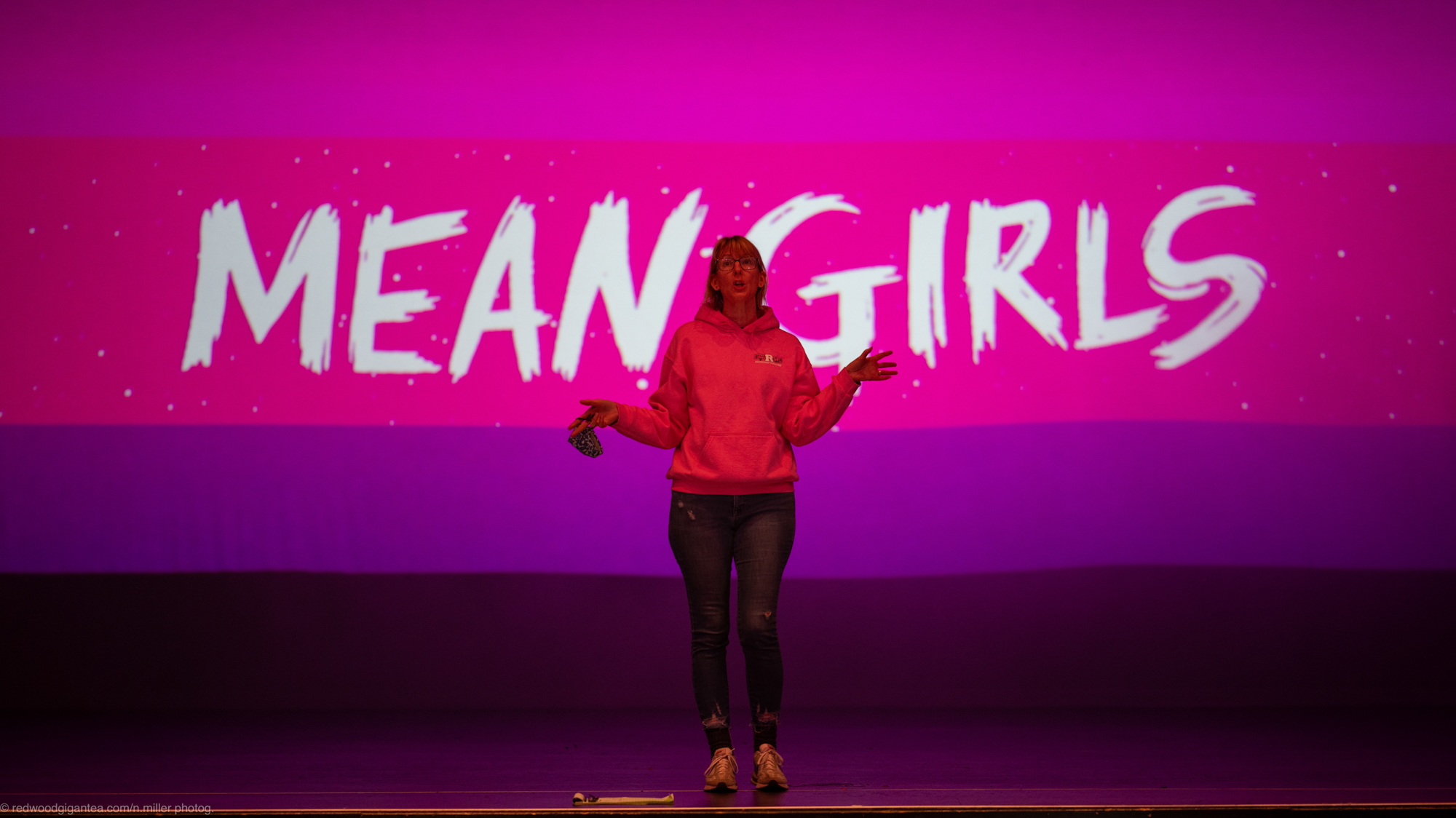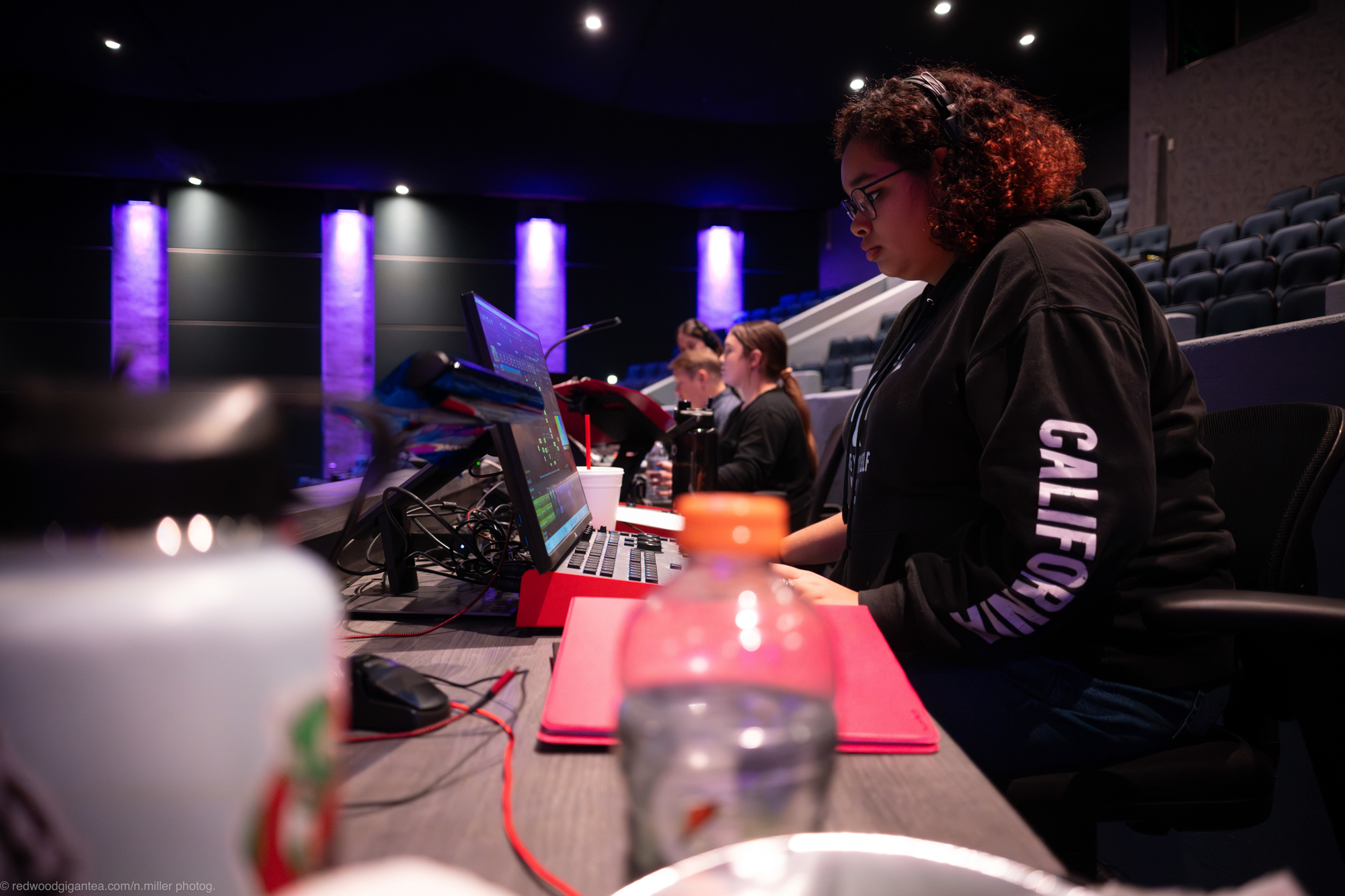By Isabella Chan
The little details in a story can truly bring out quite a mean show. Things that we as the audience may never think about add to the effect that the show imprints.
Behind the scenes, there are staff that don’t get to shine in the spotlight and work put long before rehearsals even start. But the time and work they have put into the show have enhanced the experience for audiences to remember and enjoy.
Auditions for the musicals every year start in October, but preparation for the performance starts many months prior. Once the musical from last year comes to an end around March or April, thoughts and ideas start to stir up for the next year.
Stacy Galvan, Redwood’s theater teacher, immediately thinks about the current freshmen, sophomores, and juniors and what musical would be best for them.
Before the end of the school year, the show is revealed. This year, as everyone now knows, Galvan had chosen to do the Broadway version of the hit 2000’s chick-flick Mean Girls.

Performing Mean Girls is arguably quite different compared to past musicals Redwood has performed for. With such a different show Galvan explained, “We had to have a nice chat with the cast and have them understand that we have to do these horrible things. It’s called ‘Mean Girls’, they are mean!” She needed the actors to show how mean their characters were so the message of the story could come through and the good show at the end.
Over the summer Galvan would read over the script lightly, the process called a ‘scene-to-scene’, in which she’ll look over what the show specifically needs to max out the show. The props are set by the script. Once decided what she needs, she looks over what is possible to achieve for the performance.
It’s a full-year process to build the show, deciding what they need, and what they want, and the cast looks forward to presenting their hard work. Crafting any production is what Galvan would call, a creative process.
Most of us think straight to the 2 weeks in the L.J. Theater as most of their rehearsal time, but it only scratches the surface of time put into the production.
As most of the time is put into thinking about the show, the cast ends up practicing around 9 hours a week. That may not sound like much compared to other schools that practice nearly every day, but they are able to knock out goals successfully with each practice. It’s crazy putting it into perspective knowing that there are around 12 dance numbers that require a full ensemble.
The musical this year is rather enhanced compared to past ones. With the revamp of the L.J. Williams Theater, the show will “absolutely, 100%” improve the show Galvan says. Galvan and her other staff have a completely new light and sound system to play with. She describes the new sound system as “just beautiful”, and without a doubt leaves the impression of a marvelous production.
“I’ve already told the cast and the director’s team and the crew that I’m going to be super tired because I have a feeling I’m going to be at the theater till like 3 o’clock in the morning just playing with the house lights!” Galvan says enthusiastically.
Galvan describes the new lights as you would see in a Disney show. Each light is individually programmed and above the audience seats. Lights like these are used to create effects and ambiance like lightning and thunder.
“If anybody’s ever been to Disneyland and you go into one of their theaters and you’re watching one of their shows, that’s exactly what they do. We don’t even realize that it’s happening unless a light hits you in the eye,” she laughs.
With so many new lights it’ll be able to enhance the effect on the music and scenes going on in the show, especially with the audience lights.

Up on the balcony, Galvan also has returning Redwood students, Rebecca Acevedo working on the lights, and Nathaniel Crabtree helping out as stage manager. Both Acevedo and Crabtree are currently at COS working in theater and stagecraft.
“I’m saying it’s going to be awesome, I’m hoping it’s going to be awesome, it’ll depend on what we can program and our team of people,” says Galvan.
As awesome as the production has come to be, the obstacles they had faced hit them like a bus. With Galvan wanting the show to be something relevant and relatable, there were people in the community opposed to performing Mean Girls.
A more conservative community wanted a classic stereotypical musical. However, Galvan would argue that musicals such as ‘West Side Story’ would be seen as more ideal and appealing to all ages. Despite it being a classic, it isn’t family-friendly like certain people want it to be.
Galvan explains, “Are they family-friendly [West Side Story]? No. Musicals like West Side Story have 3 murders on stage. That’s not a family-friendly show. It’s a classic show, but people mistake classic for family-friendly.”
Galvan also explains how this musical is not like any ideal classic one such as Oaklahoma or Music Man. “It literally just keeps rolling, there’s very few blackouts. The blackouts are very intentional, we’re [the audience] made to feel ‘oh!’ something happened.” she says.
Students usually want to, “end number, run off stage” but they can’t do that for this production. The lack of blackouts requires the cast to stay in character and once the last note of the song hits, the show is already in the next scene.
L.J.’s new system includes a projector which they have used to the max to represent the fast scene changes and any comedic impact.
The transitions are super important and very difficult.
Swiping a screen to change a scene seems easy, but onstage the cast is in a rush to smoothly transition into the next act. “It looks easy, it’s not,” says Galvan. The desks for classroom scenes are on wheels put together by stagecraft,
Through the disapproval of the show, Galvan finds that the students are having “the time of their lives” because the show is something they can relate to. It’s in a similar time era, and age group, and even down to their speech it’s all relatable.
Regarding the performance aspect of the musical, Galvan believes overall that her goals for the show were met. “The show is very projection-heavy,” according to Galvan. To make a full impact, props are needed. Thanks to the Redwood community Galvan is able to receive the support to bring the show together.
“But the thing I’m most proud of is how the students are just handeling it and how our team of directors went into this going ‘okay, we know this one’s going to be hard. It’s something different that we’ve never done before,’”
Stacy Galvan
During Galvan’s 4th period, she’s teaching her stagecraft class of 18 students who work on props not only for Redwood’s musical but for the other middle schools in Visalia. They worked on the props for Ridgeview Middle School which performed The Addams Family and Shannon Ranch Elementary School which performed Shrek the Musical.
Students in the class will do things from painting furniture – acquired from Morris Gan, owner of Chinowth Git & Go, who enjoys looking through antique stores and such behind the scenes – to learning how to manage lighting, and sound, and help with costumes.
The class splits the students into different groups to work on projects for the school theater community.
Along with Gan’s and Stagecraft’s contribution to props, Galvan has other staff members like Mr. Harris, who teaches Studio Art, who allowed the cast to borrow art easels, and the district donated 20 desks to use for classroom scenes. Other classes including Woodshop, Metal Shop, and Ag Mechanics also help with the musical to make sturdy props. The tables students stand on were made by students in Ag Mechanics.
Even with the help provided, there’s more work for the group to do. Someone is working on costumes (besides stagecraft) who’s been a part of Redwood’s theater for over 17 years and has helped other schools with their musicals like Green Acres Middle School. Galvan will send inspirational pictures to them and they’ll come up and obtain costumes for the cast to wear.
This is no easy task though despite the movies for reference. There are at least 70 students with 3 or more costumes. Not to also mention the leads have more costumes than that! The cast also has the support of the assistant choreographer working on hair and makeup.
“I’m excited to see it too [the full production]! People always say [“I can’t wait to see the show”] that to me and I’m like, by the time we get into the theater and we get to opening night, I don’t do anything! I’m done! The stage managers taken over, the choreographer might clean up some stuff here, Mr. Carillo is cleaning up vocals. I’ve done my job, there’s no more I can do! It’s up to the students, it’s up to the stage manager, it’s up to the orchestra to make everything happen by that time… Opening night, our choreographer, co-director Adrian and I are just sitting upstairs just going like, ‘okay, okay okay, oh look the audience laughed!’ or they clapped… and then we can like have a cookie and relax!”
Stacy Galvan, Redwood’s Theater Teacher
Without the support of Redwood students, teachers, and fellow supporters of the arts, we wouldn’t have an opportunity to witness performances as dynamic as this year’s show. Galvan and the Mean Girls cast have truly created a musical that is just so fetch!
Tags: action, camera, fetch, lights, Mean Girls, mean girls the musical, musical, Redwood, redwood gigantea, redwood high school, redwood journalism, redwood rangers, rhs, Wednesday's We Wear Pink

